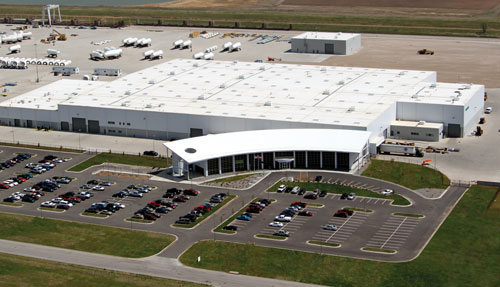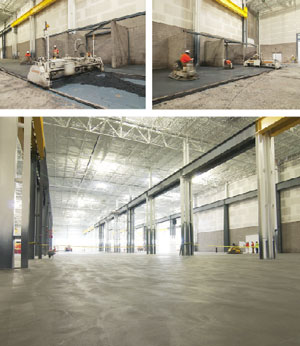Wind Turbine Manufacturer Seeks Lead with LEED
By Randall Vaughn, AIA | July 25, 2012
Category: To handle the enormous scale of the manufacturing processes, transportation logistics, and office building requirements of the new plant, Gray Construction designed a 300,000-square-foot facility, storage area, and administration building, and developed 40 acres of a 100-plus-acre campus. Sustainable strategies for energy, lighting, water, and materials are used inside the large assembly area, which is approximately the size of five football fields.
To handle the enormous scale of the manufacturing processes, transportation logistics, and office building requirements of the new plant, Gray Construction designed a 300,000-square-foot facility, storage area, and administration building, and developed 40 acres of a 100-plus-acre campus. Sustainable strategies for energy, lighting, water, and materials are used inside the large assembly area, which is approximately the size of five football fields.When Siemens Energy opened its first U.S. wind turbine nacelle factory in Hutchinson, Kan., it wanted to make sure that the building was built green. As one of the world’s largest providers of renewable energy and environmental technologies, the company embraces the same sustainability merits it sells to its customers. The Hutchinson plant is part of an ambitious green buildings initiative to align Siemens’ buildings with its sustainability commitment.
The $30-plus-million facility, which opened in December 2010, was awarded the U.S. Green Building Council’s LEED® Gold certification in September 2011 for its environmentally responsible design and efficient operating systems. The facility is Siemens’ first LEED Gold production facility in the U.S., as well as the first one in Kansas.
“LEED certification was very important to Siemens as we built this new nacelle facility in Hutchinson,” said Kevin Hazel, head of Siemens Energy Americas’ wind power supply chain management. “We are honored to receive this recognition and feel that it stands for our commitment to sustainable, energy-efficient technologies as both a user and a producer.”
Design Challenges of Green
 Figure 1The predetermined location and orientation of the building posed a thermal problem. The solution became the centerpiece of the project’s daylight-harvesting strategy. Gray installed a 4,900-sq.-ft SageGlass® electrochromic (electronically tintable) glass wall on the west façade of the office building, which is tied to the building energy management system and automatically tints based on sunlight and measured solar heat gain.
Figure 1The predetermined location and orientation of the building posed a thermal problem. The solution became the centerpiece of the project’s daylight-harvesting strategy. Gray installed a 4,900-sq.-ft SageGlass® electrochromic (electronically tintable) glass wall on the west façade of the office building, which is tied to the building energy management system and automatically tints based on sunlight and measured solar heat gain.But getting to the point of achieving LEED Gold presented several challenges for Gray Construction, the design-build firm that built the plant.
Large: The first was the enormous scale of both the technology and the facility needed to accommodate it (see lead image). The immense wind turbine nacelles contain the gearbox, drive train, and control electronics. While blades get all the glory, the nacelles do the hard work of converting the kinetic energy into electricity.
Each nacelle weighs about 85 tons and is transported over the road by a 19-axle trailer that extends more than 200 feet long. To decrease the carbon footprint and increase logistic efficiency, Siemens nacelles are increasingly transported by rail. The large turning radius required for the transport vehicle, and the need for the nacelles to be transported by rail, predetermined the location of the new manufacturing facility in an industrial park near an active railroad spur.
To handle the operations processes, transportation logistics, and office building requirements, Gray designed a 300,000-square-foot facility, storage area, and administration building and developed 40 acres of a 100-plus-acre campus. Inside the plant, the large assembly area—approximately the size of five football fields—employs several sustainable strategies for energy, lighting, water, and material use.
Heat Gain. The predetermined location and orientation of the building posed a challenge when it came to taming the sun on the west side of the building without losing daylighting benefits and a view of the outdoors.
The solution became the centerpiece of the project’s daylight-harvesting strategy. Gray installed a 4,900-sq.-ft. curtain wall of SageGlass® electrochromic “dynamic” glass on the west façade of the office building to manage solar heat gain and glare (see Figure 1).
Electrochromic glass electronically tints and clears, modulating light, heat gain, and glare inside the building. The electrochromic glass system is connected to Siemens’ building management system for manual control when needed; however, it primarily operates with automatic controls using light sensors, adjusting for time of day and seasonal sun patterns and angles. Rather than using conventional sun controls such as mechanized window shades, blinds, and louvers that tend to block sunlight and views, electrochromic glass enhances occupant comfort and enables unobstructed outdoor views. By regulating solar heat gain, it conserves energy and reduces the capacity requirements of the plant’s HVAC systems.
 Figure 2A jointless concrete floor system was installed in the assembly area. Developed in Denmark by Teqton, this was the first installation in the U.S. Teqton shipped its specialty installation equipment to the project site and provided an experienced crew to ensure the product was installed correctly. The floors are made from a solvent-free concrete and polymer blend.
Figure 2A jointless concrete floor system was installed in the assembly area. Developed in Denmark by Teqton, this was the first installation in the U.S. Teqton shipped its specialty installation equipment to the project site and provided an experienced crew to ensure the product was installed correctly. The floors are made from a solvent-free concrete and polymer blend.The installation makes the facility the world’s current largest building project with electrochromic glazing.
In addition, the company installed a “cool roof” surface and paving materials with high solar reflectance index (SRI) values to reflect heat and conserve energy (see lead image). SRI is a measure of a surface’s ability to reject solar heat. These solar control features, combined with high R-value insulation, minimize heat loss in winter and coolness in the summer. As a result, the plant uses 36.6 percent less energy than comparable manufacturing facilities (based on ASHRAE baselines).
Maximizing Natural Lighting. Despite its expansive size, the facility’s abundant windows and skylights provide natural daylight in more than 85 percent of the occupied areas. Daylighting significantly reduces the energy usage and cost of artificial lighting. But just as important, it greatly benefits the employees within. Peer-reviewed studies show that in addition to improving productivity, natural daylight in the workplace improves morale and health and relieves stress, which reduces absenteeism, among other benefits.
Shallow Water Table. The firm focused special attention on ensuring water quality. The surrounding community derives its water supply from wells, which draw from a water table that starts only 8 to 10 feet below the surface. Gray had to grade the site carefully and construct several detention ponds to guard against potential pollution problems from stormwater runoff.
Conserving Water. The wind turbine plant was constructed with intelligent water management systems, including low-flow fixtures and sensors on flush valves, which reduced plumbing water use by 41 percent. In addition, landscaping was selected from native varieties and only natural irrigation from rainfall is employed.
Reducing Emissions. The firm set aside preferred parking areas for fuel-efficient vehicles, low-emissions vehicles, and carpooled cars to reduce pollution from cars.
Lessening Land Impact. The design also promotes biodiversity by using a high ratio of open space, with 53 percent of the site dedicated to vegetation and additional land left undeveloped.
Toxins Removal From Materials. Green materials played a major role as well. Low-VOC paints, sealants, adhesives, carpets, walls, and floor finishes were used throughout construction.
To support the nacelles’ massive weight, the plant employs a high-tech Teqton jointless flooring system—the first of its kind in the U.S. Not only are the floors extremely abrasion resistant and virtually maintenance-free, they are ecofriendly, made from a solvent-free concrete and polymer blend (see Figure 2).
In addition, about 58 percent of the wood in the building was sourced from sustainably managed forests.
Diverting Landfill Waste. During construction, 84 percent of the construction waste was recycled, diverting 1,207 tons of concrete, wood, metal, cardboard, and other waste from landfills.
Investment Pays Off
Since launching its wind energy facility, Siemens Energy has hired approximately 300 workers and has produced more than 800 megawatts of clean wind generation technology in its first year of operation—enough to power more than 250,000 average households. It helped revitalize a town re-emerging from a sluggish economy by building green energy technology in a cutting-edge, green manufacturing facility.
The Siemens commitment to sustainability is proving to be good business as well. In fiscal 2010, revenue from the company’s green energy business totaled nearly $37 billion (€28 billion). As demand for clean power continues to grow, Siemens’ wind turbine nacelle factory is well positioned to play an increasingly powerful role in providing sustainable energy solutions for the country.

Side by side, we move metal fabrication forward.
FMA unites thousands of metal fabrication and manufacturing professionals around a common purpose: to shape the future of our industry, and in turn shape the world.
Learn More About FMA


